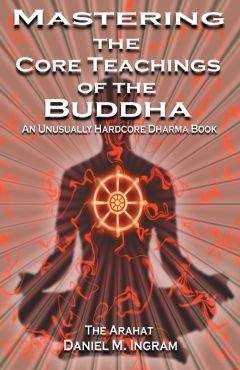Daniel Ingram - Mastering the Core Teachings of Buddha - An Unusually Hardcore Dharma Book
На сайте mybooks.club вы можете бесплатно читать книги онлайн без регистрации, включая Daniel Ingram - Mastering the Core Teachings of Buddha - An Unusually Hardcore Dharma Book. Жанр: Прочее издательство -,. Доступна полная версия книги с кратким содержанием для предварительного ознакомления, аннотацией (предисловием), рецензиями от других читателей и их экспертным мнением.
Кроме того, на сайте mybooks.club вы найдете множество новинок, которые стоит прочитать.

Daniel Ingram - Mastering the Core Teachings of Buddha - An Unusually Hardcore Dharma Book краткое содержание
Mastering the Core Teachings of Buddha - An Unusually Hardcore Dharma Book читать онлайн бесплатно
It was another six months before I went on retreat again, and luckily by that point I wanted nothing in the world more than release. In the month before I arrived, I was lucky enough to have a friend clearly explain the importance of noticing impermanence at a very fine level and show me some of the finer points of the maps. I hit the retreat determined to practice to the very best of my ability or die trying.
I powered up above the Arising and Passing Away again on day 3, hit the Dark Night on day 4, faltered for a few hours, and then simply noted. I knew I was beaten, but I noted. I was weary, tight and yet volatile, and I noted. I felt I was cracking at the seams, but I noted. I stayed with what was happening, clearly perceiving and reluctantly accepting the sensations that made up my world, the weight lifted, and then the little mush demon buddha thing showed up. Soon thereafter, I soared effortlessly in realms of pure vibrating suchness, free from the ordinary cares of the world. Soon this became boring, and then I just sat and walked. On day 6 of my fourth retreat, I got the first taste of what I was looking for (read, “stream entry”). There is no way to explain the waves of gratitude that washed over me, except that one small ripple of them was the other part of the motivation for writing this book.
236
How the Maps Help
As promised, the spiritual path is not a linear one. During the next few days, I swung wide from the greatest spiritual highs to the extremes of what can happen during Re-observation. My mind was powerful beyond reason, and yet I was a complete novice at this new territory. I was a bit like a 16-year-old who has just been given a Ferrari with no brakes and a pair of night vision goggles. I simultaneously saw myself as being staggeringly wise and also as a complete basket case. For the remainder of the retreat, I worked to stabilize, ground and regroup so that when the retreat ended I wouldn’t make a complete mess of things.
I was only moderately successful.
For the next few weeks, I, The Great Stream Enterer, managed to alienate most of the people who had the misfortune to speak with me for any length of time. Worse, within four weeks I began experiencing the difficult physical raptures of the next set of early insight stages. New territory was showing up, probably because I was still practicing hard three or more hours each day, and it was kicking my gung–ho butt. My neck went so stiff in the next 3rd insight stage that I could barely move my head for nine days, and the pain was excruciating. Again, I had no idea what was happening. Many years later, I have come to the conclusion that the best thing to do after attaining a path is to chill out for a while. I did have a senior teacher tell me that much, but he didn’t tell me why. Further, I had been advised by a good friend to do otherwise. Lord, help us when meditation teachers give us blatantly contradictory instructions, particularly in intensive practice situations.
No one had told me that the beginning of a new progress of insight could arise so quickly, or informed me of what it could be like to be trapped in the odd in-between stages by pushing too hard. Again, I wished I had the advantage of knowing someone who was willing to talk about these things honestly. However, despite my continued contact with senior meditation teachers, no one was willing to lay out the practical information that I present here. I had to figure it out the hard way. Was I bitter? You bet I was. Was I simultaneously very grateful to even have these things to be bitter about? Absolutely. Finally, someone gave me the excellent advice, “Nail down what you’ve got.” Within a few weeks of relaxing and letting things settle, I was able to backslide to mastery of the previous stages and get on with my life.
237
How the Maps Help
Despite these rough beginnings and a rough journey beyond them, do I have any major regrets? No. It has been so very beneficial that I cannot possibly explain it. I wouldn’t be going on and on about these things if they weren’t worth it. However, I am a firm believer that if there is enough good information out there, then it doesn’t have to be so hard for those that follow. Thus, I present these maps with the hope that they will help people at least have some framework to help them understand the many and varied parts of the path.
Further, as absurd as this may sound to some, the maps allow you to plan your spiritual path to some degree. True, there are ultimate points of view that would make this perspective seem quite ridiculous, but indulge me. A sample plan might be this:
1. Go on a three-week retreat and really power the mindfulness and investigation all day long, consistently stretching your perceptual threshold and speed of investigation to its limits to maximize the chances of crossing the A&P Event. It is not that hard to cross the A&P with fairly imbalanced effort, so don’t worry about that.
Remember not to be freaked out by the strange raptures around the A&P. Note, a two to three month retreat would give you a great shot at stream entry if you are ready to really practice, so if you are at that level, go for it.
2. Once you have crossed the A&P, Dark Night stuff will come bubbling up soon enough, and the choice to deal with this on or off retreat will depend upon how much time you can devote to retreats and how much intensity you can stand. My vote tends to be for on retreat if you can take the heat, but not everyone can the first time around and not everyone can easily spare the time. On the other hand, that Dark Night might just be a cakewalk. Give it a go and find out! In the Mahasi Sayadaw tradition, they typically think that two to three months of diligent noting practice on intensive retreat is enough to get many people to stream entry, but perhaps you do not have the time or dedication to step to that level yet.
3. If you decide to deal with the Dark Night off retreat, realize that you will likely fall back but keep practicing an hour or two each day. Do your very best to realize that any of the odd feelings that you may experience are probably just Dark Night side effects. Try to imitate 238
How the Maps Help
normal life as best you can and avoid rash decisions such as sudden and permanent renunciations of things you will want later on. Try to be nice to people and do your very best to keep your “stuff” from bleeding onto those around you. Find ways to honor and deal with your stuff that don’t involve projecting it out onto other people or making a mess of your life.
4. If on retreat, or the next time you can go on retreat, just keep practicing as consistently and accurately as you can and avoid indulging in the content of your stuff at all costs. Put worldly concerns behind you for that period of time and investigate bare sensations with acceptance and bravery.
5. Attain to equanimity regarding whatever arises, but be wary of indifference. This is not always as easy as it sounds, but it could be strangely easy nonetheless. Once the weight lifts, just keep sitting or walking or whatever, with no sense of special effort. After really getting into high equanimity, stream entry should arise soon enough; if it doesn’t, repeat the above cycles until it does.
6. From this point, you are “in there,” and progress of some kind is now inevitable. This first finger-hold on ultimate reality is extremely important, as without it you can wander far and wide and yet get nowhere. Advice for what to do next is given later on.
239
Mastering the Core Teachings of the Buddha
27.THE THREE DOORS
Insight practice is all about understanding the Three Characteristics
so that when we deeply understand them we may see beyond the three illusions and enter ultimate reality through one of the Three Doors.
Stages 12-14 and subsequent attainments of Fruition at that level of awakening present as radical and complete understandings of the Three Characteristics at the level of formations, i.e. at the level of the whole sensate universe, lasting three or four moments of one tenth to one quarter of a second each. As unpalatable as the Three Characteristics can seem, in the end they are the source and substance of our complete salvation.
There are three basic ways the doors may present themselves, which I will describe shortly, at least two of which are combined to produce the experience of entering ultimate reality. The third characteristic is considered inferred from the way the other two present, but sometimes aspects of that third characteristic will be experienced directly.
Regardless of the way that door manifests, there are some common characteristics of doors that point to something beyond all of this. They reveal something completely extraordinary about the relationship between “the watcher” and “the watched” that it would take a very warped view of the universe to explain, though I will try shortly. One way or another, these fleeting experiences cannot be explained in terms of our normal, four-dimensional experience of space and time, or within our ordinary experience of a subject and object.
One way to sort out a door to ultimate reality from an A&P Event is that the Three Doors involve the whole experiential space-time continuum as well as the object of investigation, as these become the same thing, an integrated whole. This does not hold absolutely for A&P
Events if we are being honest with ourselves, as the subtle background of sensations that provide reference points is not completely included.
Further, A&P Events tend to be very rich and thick, whereas there is always a sort of silent and luminous transparency to the way the Three Doors present. As stated earlier, the A&P Event occurs very much as the Three Doors, is then followed by an unknowing event, but then there are a few moments (usually about 3 or 4) as the breath drops all
The Three Doors
the way to the bottom, followed by another unknowing event and a state shift.
Without doubt, the clearest and most illuminating experiences of the Three Doors come from attaining Fruition in the formless realms or in the realms of the “psychic powers,” though these are not necessary, just very interesting, memorable and educational. Another perspective would say that the Three Doors always happen at the level of the psychic powers, but this is a matter of semantics. The strength of one's concentration practice and the recent continuity of practice will also help determine how clear these experiences are. I had to go through them hundreds of times with an eye to exactly how they presented before I was able to write a chapter such as this one. The entrance to Fruition through one of these doors is always completely unexpected.
I will explain the aspect that each characteristic lends to each door and then combine these to explain what actually happens. When particularly clear experiences of the three quick moments of the Three Doors occur, they can provide fundamental clues that can be used for further debunking the Three Illusions, as well as explaining where so many of the teachings that try to describe the true nature of things come from.
For instance, the impermanence door aspect has to do with mind moments (the particle model), arising and passing, vibrations, understanding that from which all this arises and that to which all this returns, understanding the source of all reality, the universe strobing in and out of existence, and that sort of thing. When the Tibetans talk of non-existence, they refer to the fact that all experience is utterly transient (the wave model) and thus abides or exists not at all but is constantly in absolute flux and ephemeral. The impermanence door aspect relates to realizing what is “between the frames” of the sensate universe (formations), and it tends to have a “dat.dat.dat-(gone)!” quality to it.
The suffering door aspect has to do with fundamental attachment, dropping attachment like a hot coal that one finally realized one was holding, really letting go, compassion, ultimate bodhichitta, the true love of God, being purged in the flames, renunciation, relinquishment, feeling the fundamental queasy tension in the illusion of duality for just a bit longer than one ever would normally, and that sort of thing. The 241
The Three Doors
suffering door relates directly to “the mind” releasing its fixated hold on the whole of relative reality and allowing it to fall away, leaving
“awareness” to discover itself. Remember, these words in quotes do not refer to fixed phenomena or experiences. It can also feel like the sum total of existence is suddenly ripped away from us. The suffering door aspect tends to be the most unsettling or wrenching of the Three Doors, the most death-like.
The no-self or emptiness door aspect has to do with the teachings on the mirror-like nature of the mind, the Spirit of God moving upon the face of the waters (that oh so mystical and overlooked line from Genesis 1.2), God making man in his image, merging with a tantric image of a buddha, seeing one's Original Face, thinking of who created thought, and that sort of thing. It relates to directly observing the collapse of the illusion of duality, the collapse of awareness into the intelligence or cognition of the perceived. It is a bit like staring back at yourself (or something intelligent regardless of whether or not it looks like you) with no one on this side to be stared at and then collapsing into that image. The emptiness door aspect tends to be the most pleasant, easy and visually interesting of the three.
Each of these doors has to do with complete understanding of the ultimate aspect of relative reality, and thus realizing the ultimate nature of ultimate reality. Each door also relates in some way to completely countering one of the three fundamental defilements. The
impermanence door relates to countering fundamental ignorance. The suffering door relates to countering fundamental attachment. The emptiness door relates to countering fundamental aversion. From a True Self point of view, the impermanence door relates to the permanence of ultimate reality, the suffering door relates to the compassionate nature of ultimate reality or ultimate bodhichitta, and emptiness door relates to the fact that The Void is “what” we truly are (in True Self parlance at least).
When I use the word “fundamental,” I always mean something to do with basic illusions of duality or the gradual or sudden elimination thereof. Thus, I use the word “fundamental” when what I am talking about has nothing to do with specific content, emotions, physical 242
The Three Doors
sensations, mind states, psychological manifestations or understandings, or any other specific and limited categories of sensations.
I will now try to describe six possible combinations of these three aspects that create the actual experiences of the three doors. While there can be quite a lot of variation in the specifics of how these doors present, they will always fall into one of these basic patterns. As I stated earlier, these events are so brief and sometimes so unclear that persons who have been through them many times may not understand that they present in the way I describe them here.
When the impermanence aspect predominates and is combined
with the emptiness aspect, then the whole universe strobes three times quickly with something staring back at us as a minor aspect of that universe, and then it seems that awareness collapses into the space after the third gap, perhaps turning slightly towards the thing that was staring back. When the impermanence aspect predominates and is combined with the suffering aspect, then the three strobing moments feel wrenching, and the plunge into the gap feels fundamentally violating, like exactly the wrong thing to do.
Похожие книги на "Mastering the Core Teachings of Buddha - An Unusually Hardcore Dharma Book", Daniel Ingram
Daniel Ingram читать все книги автора по порядку
Daniel Ingram - все книги автора в одном месте читать по порядку полные версии на сайте онлайн библиотеки mybooks.club.




